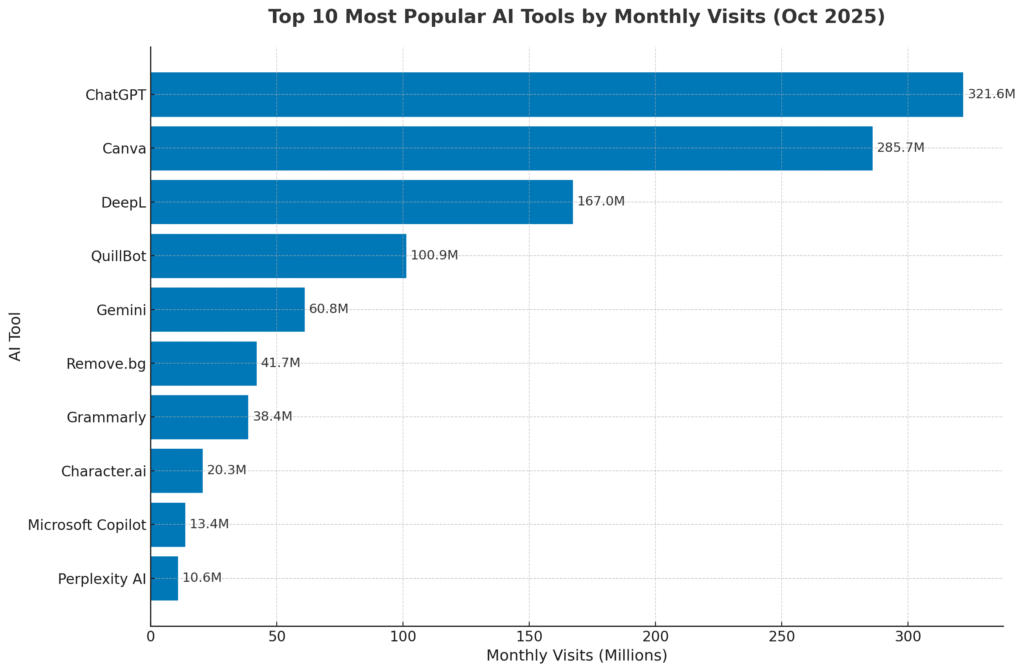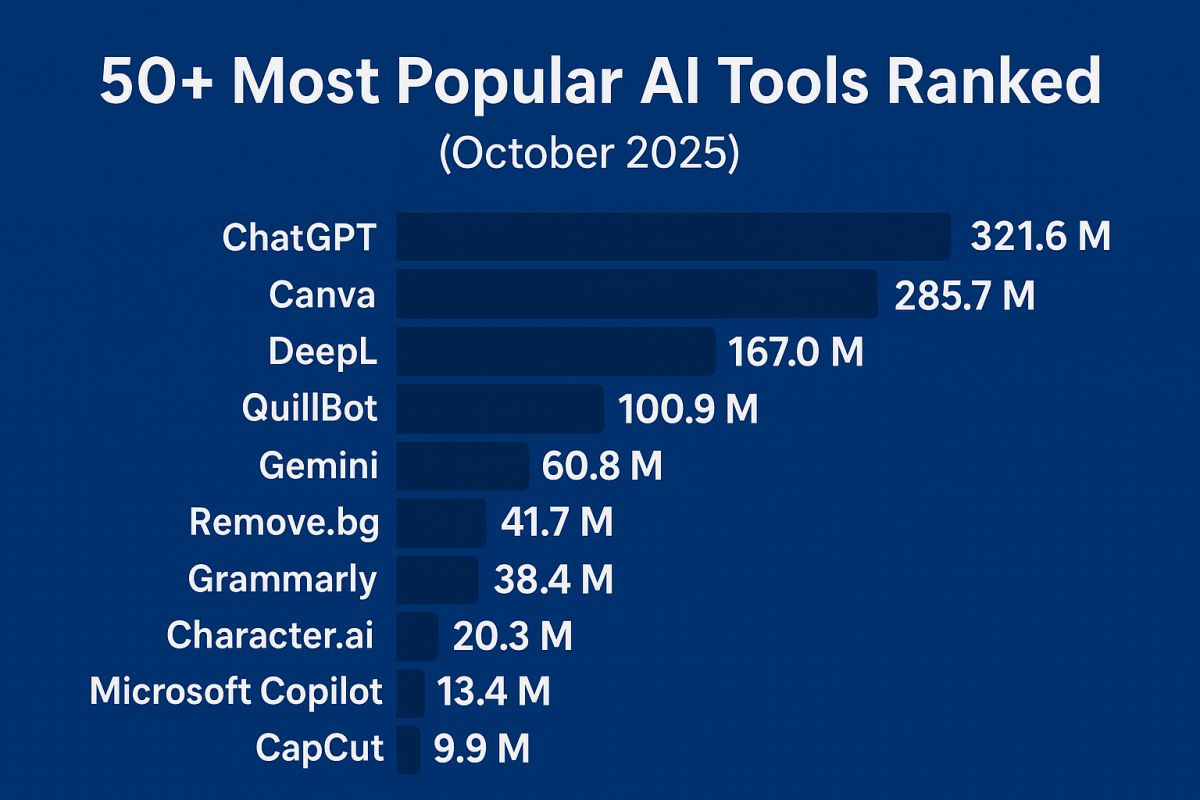As of October 2025, over fifty AI tools stand out as leaders in the field based on their estimated monthly organic web traffic. This ranking is based on SEMrush traffic estimates and reflects usage via web access only (i.e. app or API use is not included). In practice, many of these tools have even larger active user bases when considering mobile and integration access.
Below, you’ll find:
- A snapshot of which tools draw the most visits
- Which ones are growing fastest in popularity
- Ten standout AI tools worth special attention
- The full ranked list of 65 tools by traffic and market share
- Some observations about trends and what drives adoption
Top AI Tools by Monthly Traffic (October 2025)
At the top, ChatGPT remains dominant, drawing over 321.6 million monthly organic visits. It alone accounts for nearly 28% of the combined traffic among these top 65 AI tools.
Behind ChatGPT, a few names leap out:
- Canva: ~285.7 million visits (~25%)
- DeepL: ~167 million (~15%)
- QuillBot: ~100.9 million (~9%)
- Gemini: ~60.8 million (~5%)
Beyond the top five, many tools also command multi-million visit volumes, contributing to a broad and competitive AI ecosystem.
⚠️ Remember: these numbers only reflect web access (via browsers). They omit usage via apps, APIs, or integrations—so the actual user base for many tools is substantially larger.
Fastest-Growing AI Tools (Six-Month Surge)
Beyond absolute popularity, which tools are accelerating fastest? These stand out in terms of six-month growth:
- DeepSeek – +88.6%
- Google AI Studio – +80%
- NotebookLM – +57%
- Cursor – +56%
- Perplexity AI – +37.7%
A common theme: many of these fastest growers remain largely free or offer compelling free tiers. For instance:
- DeepSeek hasn’t introduced paid plans yet, relying on free access to scale
- Google AI Studio is a no-cost, experimental interface to Google’s Gemini / Gemma models
- NotebookLM and Cursor do offer premium tiers, but their free versions are sufficient for many users, which helps attract new users
- Perplexity, while having a free tier with limitations, still sees strong growth—though slower than the fully free options
The takeaway: in the early stages of AI adoption, offering robust free tools helps accelerate growth and user acquisition.
10 Highlighted AI Tools You Should Know

Below are ten AI tools from the list with intriguing features, high usage, or rapid adoption worth spotlighting:
1. Perplexity AI
- 5-year search growth: ~8,100%
- Monthly traffic (organic): ~12.5 million
- User base: Over 15 million monthly active; ~100 million queries/week
Why it’s interesting:
Perplexity is a chat-based AI search engine that combines conversational modeling with real-time web referencing and citations — making its responses more verifiable than many chatbots. It’s strong in research, and recently added shopping features (for Pro users) so you can explore, compare, and purchase products directly in chat. They also launched Comet, an AI-driven browser extension, extending the tool toward productivity. The inclusion of free product delivery options is another differentiator fueling adoption.
2. Claude (Anthropic)
- 5-year search growth: ~8,700%
- Monthly traffic (organic): ~6 million
Why it matters:
Claude prioritizes safety and balanced outputs (“helpful, honest, harmless”). In 2025, Anthropic expanded its lineup with Claude Opus 4, Sonnet 4, and incremental upgrades like Opus 4.1. Backed by massive funding rounds, Anthropic’s aggressive growth and branding as a “responsible AI” alternative make Claude one to watch.
3. Google Gemini
- 5-year search growth: ~4,400%
- Monthly traffic (organic): ~60.8 million
Why it’s prominent:
Formerly Bard, Gemini is Google DeepMind’s flagship multimodal model family. It handles chat, image generation, translation, code, and more. Its adoption is bolstered by integration with Google One, and the Gemini mobile app has amassed over 500 million downloads since its launch in early 2024.
4. Microsoft Copilot
- 5-year search growth: ~6,500%
- Monthly traffic (organic): ~13.4 million
Why it’s key:
Microsoft Copilot integrates AI across productivity workflows, leveraging models via Microsoft’s partnership with OpenAI. It supports tools like Word, Excel, and Outlook, and includes capabilities from DALL·E 3, GPT-5, and GPT-4o. Microsoft claims over 1 million paying users and adoption by more than 37,000 organizations.
5. DeepL
- 5-year search growth: ~126%
- Monthly traffic (organic): ~167 million
Why it’s widely used:
DeepL is trusted for high-quality neural translation across 31 languages, with more natural phrasing than many alternatives. Their newer tool, DeepL Write, assists with writing — providing grammar, clarity, tone, and style suggestions. Over 10 million users benefit monthly, with a strong base of Pro subscribers.
6. Canva
- 5-year search growth: ~900%
- Monthly traffic (organic): ~285.7 million
Why it dominates visually:
Canva is a design suite that allows users to build graphics, presentations, logos, social media posts, and more. Their Magic Studio features AI-powered tools for text, design, and image generation. Canva regularly reports 200+ million active users, making it a go-to for creatives and marketers.
7. Poe
- 5-year search growth: ~63%
- Monthly traffic (organic): ~3 million
Why it’s unique:
Created by Quora, Poe is a chatbot aggregator where users can play with different models (e.g. Claude, DeepSeek R1, GPT variants) in one interface. It supports bot creation and model switching. The app has monetized via paid subscriptions, generating ~USD 7.3 million from 40,000 users.
8. DeepAI
- 5-year search growth: ~5,800%
- Monthly traffic (organic): ~7.8 million
Why it’s versatile:
DeepAI hosts a suite of AI services — from conversational chat to image, video, and music generators — under one roof. It’s a multipurpose platform that appeals to experimental users and developers alike.
9. ElevenLabs
- 5-year search growth: ~7,700%
- Monthly traffic (organic): ~1.8 million
Why it’s notable:
ElevenLabs specializes in advanced speech synthesis — including text-to-speech, voice cloning, and voice conversion. Users can generate audio in 29 languages with 120+ unique voices. The company crossed 1 million registered users in early 2024, backed by a $80M Series B round.
10. CapCut
- 5-year search growth: ~2,900%
- Monthly traffic (organic): ~9.9 million
Why it’s viral:
Subsidiary of ByteDance, CapCut is a video editing tool powering many social media creators, especially on TikTok. It includes AI tools like background removal, auto-captions, text-to-speech, templates, and a music library. With nearly half a billion mobile users, it captures a massive creator audience.
Trends & Insights: What’s Driving AI Tool Adoption?
1. Conversational & writing AI tools lead the pack
Chatbots, writing assistants, and general-purpose generative models dominate in traffic. Tools like ChatGPT, Gemini, QuillBot, and Claude are among the most visited, reflecting broad demand for content creation, ideation, and assistance.
2. Visual & media AI tools are surging
Design, image editing, video creation, and speech tools also attract large audiences. Canva, CapCut, ElevenLabs, and DeepAI show that creative AI is a major growth vector.
3. Free or generous free tiers catalyze growth
The fastest-growing tools often remain free or offer compelling free tiers. That lowers the barrier for adoption and virality, then monetization generally follows.
4. Traffic doesn’t tell the full story
Because app usage and API/integration access aren’t captured, many tools are underrepresented here. For example, many enterprise or embedded AI systems may have huge user bases but low web traffic.
5. The landscape shifts quickly
New entrants like DeepSeek can cause disruption in usage trends. Popularity is fluid — today’s breakout may not dominate a year later. This is why frequent data updates are crucial.
Full Ranking: Top 65 AI Tools by Traffic & Share
Below is the full ranking of 65 AI tools based on estimated monthly organic traffic, along with their approximate market share among this group.
Top 65 Popular AI Tools by Monthly Visits
| Ranking | AI Tool | Monthly Traffic | Estimated Market Share |
| 1 | ChatGPT | 321,600,000 | 28% |
| 2 | Canva | 285,700,000 | 25% |
| 3 | DeepL | 167,000,000 | 15% |
| 4 | QuillBot | 100,900,000 | 9% |
| 5 | Gemini | 60,800,000 | 5% |
| 6 | Remove.bg | 41,700,000 | 4% |
| 7 | Grammarly | 38,400,000 | 3% |
| 8 | Character.ai | 20,300,000 | 2% |
| 9 | Microsoft Copilot | 13,400,000 | 1% |
| 10 | Perplexity AI | 10,600,000 | <1% |
| 11 | CapCut | 9,900,000 | <1% |
| 12 | DeepSeek | 9,700,000 | <1% |
| 13 | DeepAI | 7,800,000 | <1% |
| 14 | Claude | 6,000,000 | <1% |
| 15 | Zapier | 4,400,000 | <1% |
| 16 | Suno | 4,000,000 | <1% |
| 17 | Gamma | 3,900,000 | <1% |
| 18 | Google AI Studio | 3,500,000 | <1% |
| 19 | ElevenLabs | 3,500,000 | <1% |
| 20 | Hugging Face | 3,000,000 | <1% |
| 21 | Poe | 3,000,000 | <1% |
| 22 | Janitor AI | 3,000,000 | <1% |
| 23 | Midjourney | 2,600,000 | <1% |
| 24 | Leonardo | 2,500,000 | <1% |
| 25 | InVideo | 2,000,000 | <1% |
| 26 | Runway | 1,900,000 | <1% |
| 27 | Replit | 1,800,000 | <1% |
| 28 | Cursor | 1,600,000 | <1% |
| 29 | Consensus | 1,500,000 | <1% |
| 30 | n8n | 1,300,000 | <1% |
| 31 | Luma AI | 1,000,000 | <1% |
| 32 | Filmora | 944,900 | <1% |
| 33 | HeyGen | 917,800 | <1% |
| 34 | Grok | 800,700 | <1% |
| 35 | Otter.ai | 714,300 | <1% |
| 36 | Manus | 680,900 | <1% |
| 37 | OpusClip | 637,200 | <1% |
| 38 | you.com | 601,500 | <1% |
| 39 | Synthesia | 591,300 | <1% |
| 40 | Descript | 546,000 | <1% |
| 41 | Microsoft Designer | 490,400 | <1% |
| 42 | NotebookLM | 473,600 | <1% |
| 43 | Wordtune | 435,900 | <1% |
| 44 | Lovable | 432,700 | <1% |
| 45 | WriteSonic | 432,200 | <1% |
| 46 | Kimi | 393,700 | <1% |
| 47 | Pictory | 386,800 | <1% |
| 48 | Jasper | 356,500 | <1% |
| 49 | Murf.ai | 352,100 | <1% |
| 50 | Play.ht | 346,700 | <1% |
| 51 | Krisp | 310,300 | <1% |
| 52 | Copy.ai | 269,700 | <1% |
| 53 | Beautiful.ai | 237,000 | <1% |
| 54 | SlidesAI | 234,300 | <1% |
| 55 | Groq | 207,600 | <1% |
| 56 | Fliki | 203,900 | <1% |
| 57 | Lumen5 | 189,400 | <1% |
| 58 | Stable Diffusion | 127,600 | <1% |
| 59 | Pi | 124,800 | <1% |
| 60 | Wayground (formerly Quizizz) | 110,600 | <1% |
| 61 | Rytr | 69,800 | <1% |
| 62 | Resemble | 68,700 | <1% |
| 63 | HyperWrite | 58,100 | <1% |
| 64 | Tabnine | 54,100 | <1% |
| 65 | Mem | 36,000 | <1% |
Key Takeaways & Strategic Suggestions
1. Traffic ≠ total usage
Many AI tools are consumed via apps, integrations, or APIs, none of which show up in organic web traffic data. A tool with lower web visits may still have vast reach if embedded in popular platforms.
2. Offer a compelling free tier
Especially in emerging fields like AI, giving users something meaningful for free attracts wide adoption. Once users are engaged, monetization (Pro plans, enterprise features) can follow.
3. Differentiate by specialty or quality
While many AI tools overlap in features, those that excel at niche tasks (e.g. translation, voice, media, research) or deliver higher-quality outputs tend to retain users and spread via word-of-mouth.
4. Stay agile & responsive to trends
Because the AI space evolves rapidly, tools must iterate fast, adjust to user needs, and innovate. The rising popularity of DeepSeek is a reminder: newcomers can shift market dynamics quickly.
5. Monitor integrations & platforms
A tool’s success increasingly depends on how well it integrates with ecosystems (software suites, APIs, platforms). AI embedded in productivity suites, social media tools, or content workflows can tap into existing user bases.
FAQs
1. What are the most popular AI tools in October 2025?
ChatGPT, Canva, DeepL, QuillBot, and Gemini are the leading AI tools based on monthly traffic.
2. Which AI tools are growing the fastest?
DeepSeek, Google AI Studio, NotebookLM, Cursor, and Perplexity AI have shown the highest growth over the past six months.
3. How is the popularity of AI tools measured?
Popularity is determined by estimated monthly website visits using Semrush traffic data from October 2025.
4. Do these rankings include app users?
No, rankings are based on web traffic only. Actual user bases are likely much higher due to mobile app and API usage.
5. Which AI tools are free to use?
DeepSeek, Google AI Studio, and NotebookLM offer powerful free versions attracting millions of new users.
6. What type of AI tools are most in demand?
Conversational chatbots, writing assistants, and AI-powered design tools dominate the global AI market.

